Sn2 reaction - Study guides, Class notes & Summaries
Looking for the best study guides, study notes and summaries about Sn2 reaction? On this page you'll find 175 study documents about Sn2 reaction.
Page 3 out of 175 results
Sort by
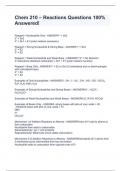
-
Chem 210 – Reactions Questions 100% Answered!
- Exam (elaborations) • 6 pages • 2024
- Available in package deal
-
- $13.99
- + learn more
Reagent = Nucleophile Only - ANSWER1° = Sn2 2° = Sn2 3° = Sn1 + E1 (polar medium necessary) Reagent = Strong Nucleophile & Strong Base - ANSWER1° = Sn2 2° = E2 3° = E2 Reagent = Weak Nucleophile and Weak Base - ANSWER1°/2° = No Reaction 3°/resonance stabilized carbocation = Sn1 + E1 (polar medium necessry Reagent = Base Only - ANSWER1° = E2 or Sn2 (if unhindered and no beta-hydrogen with unhindered base) 2° = E2 3° = E2 Examples of Only Nucleophiles - ANSWERCl⁻, ...
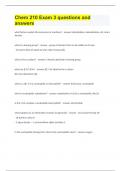
-
Chem 210 Exam 3 questions and answers
- Exam (elaborations) • 11 pages • 2023
-
Available in package deal
-
- $14.99
- + learn more
what factors explain the outcomes of reactions? hybridization, delocalization, eN, atom density what is a leaving group? - group of atom(s) that can be stable on its own - eN atoms that are good LG also make strong acids what is the α carbon? C directly attached to leaving group what are β Cs? β Hs? βC: C(s) attached to α carbon βH: H(s) attached to βC what is a LB? is it a nucleophile or electrophile? lewis base, nucleophile what is nucleophilic ...

-
Organic Chem Exam 3 Questions and Answers
- Exam (elaborations) • 9 pages • 2024
-
Available in package deal
-
- $12.49
- + learn more
alkyl halide - Answer-compounds in which a halogen is connected to an sp3 hybridized carbon atom 2 types of rxn's alkyl halides go under - Answer-substitution and elimination substitution reaction - Answer-when treated with a nucleophile, the nucleophile replaces the halogen elimination reaction - Answer-when treated with a base, a pi bond will form creating an alkene what functions does the halogen serve in an alkyl halide - Answer-1) halogen withdraws electron density leaving the ...

-
Orgo Synthesis Questions & Answers 2023-2024 A+ Review
- Exam (elaborations) • 7 pages • 2024
- Available in package deal
-
- $13.19
- + learn more
Orgo Synthesis Questions & Answers A+ Review Alcohol Synthesis from Methyl - ANS-NaOH (SB) --> Sn2 Substitution of OH and LG Alcohol Synthesis from 1*C - ANS-NaOH (SB) --> Sn2 Substitution of OH and LG Alcohol Synthesis from 2*C - ANS-Na(OAc) + NaOH --> SnAc Substitution of OH and LG Alcohol Synthesis from 3*C - ANS-H20 (WB) --> Sn1 Substitution of OH and LG (C+ Rearrangement) Alcohol Elimination (Dehydration) from Methyl - ANS-No reaction Alcohol Elimination (Dehydration)...
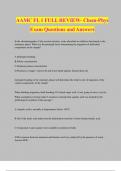
-
AAMC FL 1 FULL REVIEW- Chem-Phys Exam Questions and Answers
- Exam (elaborations) • 23 pages • 2024
-
- $13.49
- + learn more
AAMC FL 1 FULL REVIEW- Chem-Phys Exam Questions and Answers In the chromatography of the reaction mixture, water absorbed on cellulose functioned as the stationary phase. What was the principal factor determining the migration of individual components in the sample? A.Hydrogen bonding B.Solute concentration C.Stationary phase concentration D.Thickness of paper -Answer-B and D are dumb options. Knock them out. hydrogen bonding to the stationary phase will determine the relative rate of m...

-
Science 0rganic chemiStry mechaniSm of a reaction
- Exam (elaborations) • 14 pages • 2024
-
- $17.99
- + learn more
Science 0rganic chemiStry mechaniSm of a reaction How do you get a disaccharide? - ANS-From the same reaction that gave us the glycoside! Its just that now the alcohol is.....ANOTHER MONOSACCHARIDE! YAY! What kind of bond does Cellulose have vs Starch and glycogen? - ANS-BETA 1, 4 vs the ALPHA of starch and glycogen (some α 1,6 in there too!) Basic structure of an Amino Acid - ANS- a central carbon atom attached to a hydrogen, an acidic carboxyl group (−COOH), an amino grou...

-
CHM 219 MODULE 4 EXAM | QUESTIONS & ANSWERS (VERIFIED) | LATEST UPDATE | GRADED A+
- Exam (elaborations) • 8 pages • 2024
-
- $10.99
- + learn more
1 CHM 219 MODULE 4 EXAM | QUESTIONS & ANSWERS (VERIFIED) | LATEST UPDATE | GRADED A+ Organohalides Correct Answer: Organic molecules contains Halogen atoms. Ex. Algae, Mollusk, sponges, can be industrially used - solvents, insecticides, herbicides, cleaning fluids, fire retardants, refrigerants. Can also be used as inhaled anesthetic. More important in organic chemistry because of theur reactivity. Two of the most important reaction types typical of organic Halides are.... Corr...
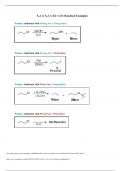
-
CHM 2210 SN2 vs SN1 vs E2 vs E1 Reaction Examples
- Other • 5 pages • 2023
-
- $15.49
- + learn more
SN2 vs SN1 vs E2 vs E1 Reaction Examples Primary Substrate with Strong Nuc / Strong Base: Primary Substrate with Strong Nuc / Weak Base: Primary Substrate with Weak Nuc / Strong Base: Primary Substrate with Weak Nuc / Weak Base:
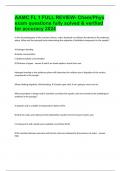
-
AAMC FL 1 FULL REVIEW- Chem/Phys exam questions fully solved & verified for accuracy 2024
- Exam (elaborations) • 24 pages • 2024
- Available in package deal
-
- $14.99
- + learn more
In the chromatography of the reaction mixture, water absorbed on cellulose functioned as the stationary phase. What was the principal factor determining the migration of individual components in the sample? A.Hydrogen bonding B.Solute concentration C.Stationary phase concentration D.Thickness of paper B and D are dumb options. Knock them out. hydrogen bonding to the stationary phase will determine the relative rate of migration of the various components in the sample. When thinking ...
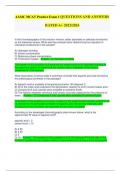
-
AAMC MCAT Practice Exam 1 QUESTIONS AND ANSWERS RATED A+ 2023|2024
- Exam (elaborations) • 61 pages • 2023
-
- $13.49
- + learn more
AAMC MCAT Practice Exam 1 QUESTIONS AND ANSWERS RATED A+ 2023|2024 In the chromatography of the reaction mixture, water absorbed on cellulose functioned as the stationary phase. What was the principal factor determining the migration of individual components in the sample? A) Hydrogen bonding B) Solute concentration C) Stationary phase concentration D) Thickness of paper - Answer - A) Hydrogen bonding The answer to this question is A because the relative amount of hydrogen bonding to t...

How much did you already spend on Stuvia? Imagine there are plenty more of you out there paying for study notes, but this time YOU are the seller. Ka-ching! Discover all about earning on Stuvia


